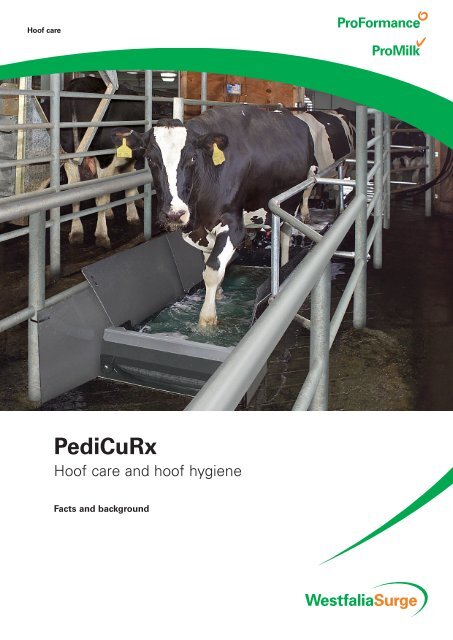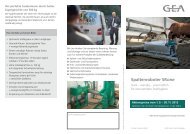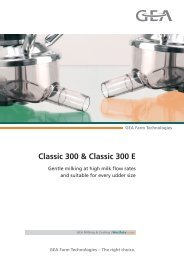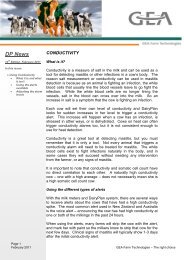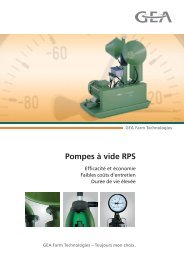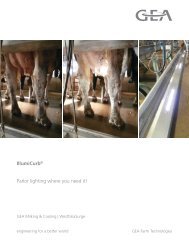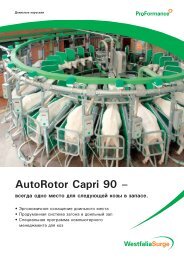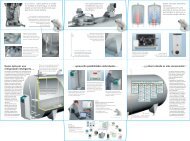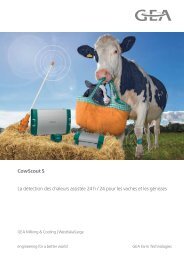PediCuRx Guidebook - GEA Farm Technologies
PediCuRx Guidebook - GEA Farm Technologies
PediCuRx Guidebook - GEA Farm Technologies
You also want an ePaper? Increase the reach of your titles
YUMPU automatically turns print PDFs into web optimized ePapers that Google loves.
Hoof care<strong>PediCuRx</strong>Hoof care and hoof hygieneFacts and background
Hoof care / lamenessBackground informationLearn more about this costlyherd health problemHoof careFacts and background4
Economic impact of hoof problemsDirect and indirect cost of important diseases in dairy cow farming(in Euro per case)direct 1 indirect 2 totalClinical mastitis average 170 91 261low grade 114 - 114high grade 297 220 517Lameness on average 133 219 352Sole ulcer 170 390 560Interdigital phlegmon 83 78 1611direct: Veterinary costs, medicaments, work time, unsaleable milk2indirect: Reduction in milk yields, increased time between calving, increased replacement frequencySource: 32nd Viehwirtschaftliche Fachtagung (Livestock farming symposium) , HBLFA Raumberg-Gumpenstein 2005(after Kossaibatietab.)It is difficult to say down to the last penny, what costs the milk producer actuallyincurs due tolameness. However, all experts are agreed that hoof diseases contributesignificantly to costs when all the consequences are taken into consideration.The average costcaused by hoofproblems andlameness is some300 euros per cowper yearThese include: reduced milk production reduced lactation periods weight loss as a result oflack of food intake increased incidenceof mastitis reduced fertility costs for veterinary treatmentand drugs increased work load and labour costs more emergency culling.The latest investigations indicate that one lame cow results in average costs of around150 euros . These include additional work, possible emergency treatments (e.g. withantibiotics) and the total loss of milk output. However costs resulting from the loss ofmilk production before lameness becomes obvious and during recovery were notincluded. Moreover, losses resulting from reduced oestrus during illness which couldlead to a missed insemination cycle, are not included. If these indirect costs are alsoincluded, then clinical lameness results in an overall increased cost of around 300 eurosper cow per year. A farm with 100 cows has a lameness rate of 10 %, so losses ofaround 3,000 euros.Theoritcal cost savings per year for an improvement of 10% in hoof healthHoof careNumber of animalsFacts and background5
The anatomy of the hoofThe diseases affecting the hoof are best understood by having a good understandingof hoof anatomy. The following pages indicate that there are a whole series of causesof lameness, that occur in quite different areas of the hoof. Some diseases can betreated by a hoof bath, in others the diet, husbandry conditions or hygiene managementmust be adjusted. It is important to recognize which hoof infection is concernedand where to find the cause, because only then can an effective solution to the hoofproblem be found.Coffin JointIt is important torecognise thecauses of hoofinfections to findthe best solutionsfor prevention andtreatment.Coronary bandWallBulbHoof bones and tendonsCoronary band:The coronary band is normally soft,shiny and may be pink.Wall:The wall is smooth and shiny. Finegrooves run parallel to the coronaryband. The wall comprises a very hardtubular horn.Bulb:The bulb is located in an extension ofthe coronary band and comprises soft,rubber-type horn.Coronary cushionWallLamellaeCoronary bandCoffin BoneWhite LineSoleCross section through the hoofDigitalcushionBulbCoronary cushion:Beneath the coronary band is thecoronary cushion, a mass of elastictissue and veins. When the animal ismoving, the cushion pumps bloodthrough the foot and back into the body.Lamellae:The lower part of the inner wall iscovered by hundreds of fine groovesup to the pedal bone.Pedal bone:The triangular bone at the end of theextremity.Sole:The sole becomes thicker towards theheel, falls away from the outer wall andhas a concave shape.Digital cushion:The digital cushion lies in the bulb. Thecushion serves as an elastic shockabsorber. It can, however also serveas a pump, in order to pump the bloodback through the body of the limb, ifthe animal is moving.Hoof careFacts and background6
Causes of lamenessAs there are many different causes of lameness, they aretypically subdivided into three categories - mechanical,metabolic and microbial.MechanicalGenetic - anatomical deformations such as overextendedhocks, weak fetlocks, sickle shaped heels,spread or overlapping claws, hinny foot, more than 2claws, etc. can cause lameness or increase the likelihoodof lameness. The likelihood of inheriting thesedeformations is small, however for older cows theycan result in problems.Environment - poorly planned housing design, can drastically influence the rate oflameness in a farm. The lameness rate in a farm will increase, if:there are too few cubiclesit is too difficult or uncomfortable to lie down orstand up in the cubiclescows have to stand for too long on concrete floors(e.g. in passages and waiting areas)the path to the milking parlour is too longpassages have unfavourable slopesthe surface quality of the movement surfaces is poor(either too rough or too smooth)in hot weather, there is insufficient or too littleventilation (increases stress)Sole ulcers can often be traced back toerrors in husbandryPoor byremanagement candrastically increasethe frequency oflameness in afarm!Further conditions, that contribute more significantly to lameness:Overfilling of the waiting areas or in the area around the feeding grillswet or dirty surroundings(e.g. slurry smeared in passages, feeding and movement areas)missing or irregularly changed bedding in the cubiclespoor surface condition in the cubiclesuneven surfaces (stones, gravel)heifers who were not used to standing on concrete floors prior to calvingirregular or incorrectly executed hoof trimmingtoo frequent flying? (stress)rough handling of cows by the milking personnel (stress).These environmental factors lead, amongst other things, to problems that causelameness, e.g. sole ulcers and white line defect. Damage to the hoof horn, eitherdue to maceration, heavy loading or injury (e.g. on the edges etc.) allows the ingressof bacteria. These multiply and cause acute inflammation of the hoof. The resultingpressure causes severe pain and lameness. Treatment involves uncovering of theinfected area.Hoof careFacts and background7
Metabolic (metabolism)Laminitis or founder is an inflammation of the claw corium, which encloses thelower claw bones. It can be responsible for up to 65 % of lameness in a dairy farmand occurs most frequently during the first 100 days of lactation. It can also becaused by poor byre conditions and lack of hygiene. Generally however, incorrectfeeding with a high level of carbohydrates and too little fibre can lead too sub-acuteruminal acidosis, which, via a sequence of reactions, can lead to founder. Foundercan be detected, when it occurs in the sub-clinical form, as discolouring of the horn(yellow) and bleeding in the area of the sole horn. (If founder is detected in anexcessively large number of animals, then the diet should be considered, if aninfection disease is prevalent, then the husbandry should be optimized).Mortellaro'sdisease (Dermatitisdigitalis) is a chiefcause of lameness.It causes more thanhalf of all cases oflameness**Nigel Cook, Professor and researcherat the university of Wisconsin,Department of veterinary medicine,published in Agri-View, May 2005In cases of founder the suspension apparatus of the pedal bone at the wall horn isholed. Due to pulling of the deep flexor tendon on the rear side of the pedal bone, andthe holes suspension of the front side, a lowering and rotation of the pedal bone canbe caused. Rotation of the pedal bone causes further problems in the sole area. The tipof the pedal bone and the underlying horn are subjected to increased pressure. Thereduction in horn quality caused by the founder results in more sole ulcers, white linedefects, claw tip defects and double soles. The chronic founder hoof is characterized bymissing horn, marked ring formation in the area of the wall horn and marked concavityon the front side, which leads, amongst other things, to “lifting” of the claw tips andover extension of the deep flexor tendon.MicrobialMortellaro's disease (also known as hairy warts, Dermatitis digitalis or evenstrawberry warts)Mortellaro's disease (Dermatitis digitalis) is a painful and wasting disease, which affectsthe skin of the hoof. If it is not treated, it leads to lameness. The disease was firstdescribed by Cheli and Mortellaro in Italy (1974) and has since spread around the entireworld. The disease is particularly prevalent in large herds. A study carried out in theNetherlands between 2002 and 2003, showed the average incidence to be 21.2 % ofall cows (herd variance between 0 and 83 %). It is known that the cause is bacterial,because the disease responds to treatment with antibiotics. The disease is probablycaused by 2 or more anaerobic, partly spirochetal bacteria, which are regularly found inlesions. It cannot be excluded that other bacteria may be involved, in particular thoseliving outside the animal in damp, muddy environments and which are highly infectious.Hoof careFacts and background8
Towelling type appearance of lesionslike these can have microbial causesDermatitis digitalis is first apparent as a raw, painful redarea. The hairs around this area are either upright ormatted. Typically it is first detected in the interdigitalarea on the rear side of a rear leg hoof. As the diseasedevelops, the appearance of the lesion changes. Itbecomes grey and has a towelling type appearance.In the later stages the lesions take on a wart typeappearance, which is frequently surrounded by fibroushair-like growth. Frequently these lesions extend intothe interdigital cleft. This provides ideal anaerobicgrowing conditions for the bacteria, especially favouredby the deposition of dirt and faeces. The lesions canalso occur higher up in the area of the fetlock or thecoronary band. These lesions on the front side are primarily detected on the frontlegs, where they can be particularly painful.The severe pain, which is felt by an animal infected with Dermatitis digitalis, reducesits inclination to stand and walk, and therefore its time spent feeding. This in turn hasa negative influence on milk production and can result in a changed eating pattern andruminal acidosis, before finally causing Laminitis (founder). Dermatitis digitalis is oftenencountered with interdigital inflammation. This leads to, amongst other things, erosionof the bulb and in the advanced and chronic stages, to interdigital hoof ulcers, or limax(tylom). The presence of a hoof infection such as interdigital hoof inflammation, bulb rotor limax favours the occurrence of Dermatitis digitalis.Dermatitis inter talis (foot rot, superficial interdigital necrosis)Dermatitis interdigitalis is a light infection of the dermis (outer skin layer) of the foot,which normally occurs between the claws (interdigital cleft). It occurs most frequently,in animals that are kept in poor hygiene conditions, i.e. in the presence of dirt andfaeces and in confined spaces. It is characterized by spreading dermatitis and possiblesloughing. The disease can spread in the interdigital pocket and in the heel horn, withthe latter leading to heel horn erosion. The cow suffers from irritation and sometimespain. The originating organism is amongst others, Dichelobacter nodosus, an anaerobicbacterium.A good housingclimate andoptimised layoutare important inkeeping thehooves clean anddry and thus inpreventingmicrobialinfections.Interdigital phlegmon (panaritium)Interdigital phlegmon is an infection in the area of the interdigital cleft, that has spreadto the underlying soft tissue. Symptoms are lesions and painful swelling of the foot(phlegmon). In serious cases, it can spread to underlying structures such as bones andjoints. Affected animals can be identified because of their loss of appetite, fever andrapidly falling milk production. Possible causes are Fusobacterium necrophorum andPorphyromonas asaccharolytica (previously known as Bacteroides melaninogenicus),both are anaerobic. Injuries or damage to the foot resulting from high temperatures anddampness between the hoof claws enable the originating organism to attack the tissue.Following an attack, the animal may become lame within a few days if not treated.Phlegmon is treated by careful cleaning of the affected area and then attachment of ananti-bacterial bandage. Often systematic treatment with antibiotics is also necessary. Ifthe infection has already taken hold, it is often too late.Hoof careFacts and background9
Bulb rot (heel horn erosion, slurry heel lesions)A further infectious disease is bulb rot. Its emergenceis likewise favoured by moisture and unclean husbandryconditions. Weakening of the horn allows bacteria toget into the deeper horn layers. The originating bacteriaare mainly anaerobic Fusobacterium necrophorum undDichelobacter nodosus, which are also found in otherhoof diseases.Foot rot is a further example of abacterial hoof diseaseIn summary it can be stated that, the above listedmicrobial diseases are caused by anaerobic bacteria,which then spread from cow to cow in conditions ofpoor hygiene.The following factors may be responsible:dampness, dirty surfaces (faeces)poor hygiene (passageways not cleaned (
Summary of the most important bacterial hoof diseasesDisease Symptoms PreventionDermatitis interdigitalis(interdigital inflammation)anaerobic bacteria Inflammation of the skin inthe interdigital cleft Cracking in the bulb area Skin thickening in theinterdigital cleft up to theLimax Deformed bulb Optimize animal husbandry,in particular the climate inthe cubicle house(ventilation), ensure cleanand dry surfaces Regularly cleanpassageways Regular hoof care, use ofhoof bathsDermatitis digitalis(Mortellaro)Caused, for example, byspirochetal or otheranaerobic bacteria long upright hairs on theafflicted areas Shape and appearanceof the wound point isstrawberry-shaped,possible unpleasant smell(typical) very painful Normally only occurs in thearea of the bulb skin abovethe coronary band.Spreading into theinterdigital cleft is possible predominantly affects therear legs, but also possibleon all 4 legs Optimize animal husbandry,in particular the climate inthe cubicle house(ventilation), ensure cleanand dry surfaces Regularly cleanpassageways Regular hoof care, use ofhoof bathsPhlegmona interdigitalis(Interdigital phlegmon„Panaritium“)Acute inflammation of lowerlying areas due to anaerobicbacteria acute lameness, poorgeneral condition Swelling and redness onthe top part of the hoof mostly affects only one leg but can sporadically spreadthrough a herd Avoid primary damage tothe hooves, treat promptly,and use preventative hoofbathsBulb rot(heel horn erosion)Damage to the bulb acts asan entrance point for bacteria Visible foot rot crater Cow stability is reduced,cow walks on its hoovesunnaturally = disturbedbiomechanics Systematic application ofhoof baths Cleaning of thepassageways Professional hoof careHoof careFacts and background11
Classification of lamenessTo resolve a problem, one must first identify it. How does one recognize when acow is becoming lame? Experts have developed a classification method, thatevaluates the movement capability of cows and thus enables a direct classificationof lameness. Cows at the onset of hoof problems change their gait, well beforethey become visibly lame. Record keeping showing the frequency and degree oflameness could help in the prompt detection of hoof problems in the future andthus prevent their spreading.Avoid subsequentlameness problemsby prompt treatmentof slight ormoderately lamecows (degrees 2 and3), so that seriouslameness can beavoided. If you waituntil a cow isnoticeably limping,it may be too late(cow performancefalls even in cases ofslight lameness).After evaluation of the cows, the milk producer knows which cows to examine andhow they should be treated. If also becomes apparent if there is a fundamentalproblem with the animal husbandry which requires changing. If you use the followingclassification method (with the kind approval of the Zinpro corporation), then it isimportant to include not only cows, who are lame or seriously lame (4th and 5thdegrees), because for them the treatment requirement is already known.then futurelameness problems can be avoided by treating even slightly lame or moderately lamecows (2nd and 3rd degrees), so that they do not become seriously lame cows. If youwait until a cow is noticeably limping, it may be too late!How cows are gradedDoes the cow favour a leg?YesNoDoes the preferred legcarry weight?Is the back bentwhen standing?YesNoYesNolameness degree 4lameness degree 3lameness degree 5Is the back bentwhen walking?YesNolameness degree 2Hoof careFacts and backgroundlameness degree 112
Evaluation of cow lamenessLocomotion ScoreClinical Description:Normal1Description:Stands and walks normally.All feed placed with purpose.Locomotion ScoreClinical Description:Mildly Lame2Description:Stands with flat back, but acheswhen walks. Gait is slightlyabnormal.Locomotion ScoreClinical Description:3Moderately LameDescription:Stands and walks with an archedback. Short strides with one ormore legs.Back posture standing: flatBack posture standing: flatBack posture standing: archedBack posture walking: flatBack posture walking: archedBack posture walking: archedLocomotion ScoreClinical Description:Lame4Description:Arched back standing and walking,One or more limbs favored but atleast partially weight bearing.Locomotion ScoreClinical Description:5Severely LameDescription:Arched back, refuses to bear weighton one limb. May refuse or have greatdifficulty moving from lying position.Back posture standing: archedBack posture standing: archedBack posture walking: archedBack posture walking: archedSource: Zinpro (According to: Sprecher, D.J.; Hosteller,D.E.; Kaneene; J.B. 1997, Theriogenology 47:1178-1187)Hoof careFacts and background13
Classification of Dermatitis digitalisRegular, professional hoof care also provides an up to date overview of the type andfrequency of hoof disease. If a milk producer detects that a cow is going lame, hewill first look for the lesions characteristic of Dermatitis digitalis (Mortellaro). Anotherpossibility for detecting Dermatitis digitalis and other hoof problems is the regularuse of a professional hoof carer. He not only trims the hooves, but also looks out forpossible problems, instigates investigations into causes and treats them.The mostestablished methodfor determining theseverity ofDermatitis digitalisis the classificationof the lesions.Normally the presence and severity of Dermatitis digitalis is detected and classifiedby grading the lesions. The type of treatment depends on the position of the lesion.For example, lesions in the interdigital cleft of the hoof are more difficult to treat thansurface and easily accessible lesions.Classification of Dermatitis digitalis - grade0 NormalNo lesion visible1 Early stageTypically very painful. The lesions are small, round, moist, concave or flat and pinkor brownish in colour. Around the edges of the lesion is a wreath of upright andmatted hair. The first signs that a cow's gait is changing may be visible (slightlaming).2 Mature stageThe lesions are enlarging and spreading, are flat and grainy, show a towelling typetexture. Very painful The cow demonstrates a moderate to marked lameness.3 Chronic stageLarge, raised lesions, often with upright hair-type adenoids. Serious pain, the cowis very lame.4 Healing stageThe lesions shrink and become less painful. A black crust may form whichsubsequently falls off, thereby uncovering the underlying healthy skin.Hoof careFacts and backgroundDermatitis digitalis (Mortellaro) -early stageDermatitis digitalis (Mortellaro) -chronic stage14
Treatment and preventionMilk producers control and protect their herds against hoof problems such asDermatitis digitalis (Mortellaro), with various methods. Hoof health expertsrecommend the first 3 of the possibilities listed below, but point out that all areonly worthwhile if the measure is correctly and fastidiously executed.Methods for controlling and treating microbial hoof problemsHoof bathsUse of suitable spraysLocal treatment and dressingsCutting off of warts and lesionsBurning or freezing of wartsSystematic antibioticsHoof baths for prevention of the transmission of hoofdiseases must be regularly and correctly carried out.According to Richard Wallace, a vet at the University ofIllinois, 4 points should be investigated, if the effectivenessof a hoof bath against the spreading of Mortellaro'sdisease is to be accessed.1. How often is the hoof bath changed?Studies have shown that a hoof bath becomesineffective if organic dirt loading is too high. A hoofbath must be changed at least every 150 cows(dependent on the level of dirt), in order to effectivein preventing Mortellaro's disease.Hoof baths are aneffective option inpreventing thespreading of hoofdisease. Regularapplication and useof the correctdesign concept areimportant inachieving success!2. Are possible faeces residues on the hooves sprayed off before the cows enterthe hoof bath? Direct contact of clean hooves and heels with the hoof bath increasesits effectiveness.3. How and where are the hoof baths installed? Hoof baths should be designedso that the cows cannot walk around or defecate in them. Hoof baths should beinstalled in the milking parlour exit area. The cows should not be able to avoid passingthrough the bath.4. How often are cow baths used? The hoof bath should be a regular componentof farm hygiene measures. One hoof bath per month "is worthless", says Wallace.Determine a sensible rhythm for your farm in conjunction with the vet.As spray solutions require less time and work per cow than dressings, they areprimarily of use if an outbreak of dermatitis in a herd has assumed epidemicproportions. Sprays are most effective when the hooves have previously beencleaned. They can be applied during milking in the milking parlour.The surgical removal of lesions for treating cows displaying lameness symptoms, isgenerally not advisable. Any surgical intervention in the hoof tissue could open upnew attack surfaces for infestation by spirochetal, anaerobic or secondary bacterialorganisms. Systematic antibiotic treatments can, in certain cases, also be used fortreatment.Hoof careFacts and background15
Hoof bath products which have beenused until now:AntibioticsPro: Can be effective, work quickly.Contras: Expensive, not intended for routine application, risk of bacteria becomingresistant. There is also a risk of contamination of the milking plant if handledwithout care or if withhold times are not adhered to. Unsuitable for hoofbaths (quickly becomes inactive due to organic material, are not approved).Copper sulphatePro: Can be effective in highdoses.Contras: Contamination of soil andwater (heavy metal),currently use is limited orbanned in many countries,high volume, heavy tohandle and store, onlyeffective in high doses, cancause hooves to becomebrittle, not widely accepted,is only available byprescription in manylocations, withhold timesmust be adhered to. Canbe poisonous to sheep?FormaldehydeAdvantages of cleaning and disinfectinghoof baths:✔ No risk of accidentally milking treatedcows and contaminating saleable milk.✔ No withhold time and so no productionlosses.✔ Discussions over the side effects ofantibiotics, at a time in which foodstuffsafety is a highly sensitive topic,do not arise.✔ No danger of bacteria becoming resistant,which is always possible when antibioticsare routinely used.Pro: Considered effective by some peopleContras: Known to be carcinogenic. Breathing in or splashes can be dangerous toemployees. Formaldehyde is not intended for use in baths and can causeirritation to the skin of both humans and cows. Not recommended by themajority of hoof hygiene experts. In many countries only available underprescription. Withhold times must be adhered to.Zinc sulphatePro: Can be effective in high doses, less harmful to the environment thancopper.Contras: Effectiveness not proven, still environmentally harmful (heavy metal),possibly future legal limitations, high volume, heavy to handle and store.Hoof careFacts and background16
<strong>PediCuRx</strong> -the hoof hygiene systemThe <strong>PediCuRx</strong> hoof care concept comprises an optimum combination of technologyand chemistry and offers a successful preventative measure for maintaining healthyhooves. Hoof hygiene in conjunction with fertility and mastitis prophylaxis is a furtheressential measure for successful management of a dairy farm.The concept encompasses a pre-cleaning bath and a main bath. Suitable chemicalproducts must be available for the pre-cleaning and hygiene baths.Hoof careFacts and background17
How does the concept work?Pre-cleaning is carried out using PedicoPré from WestfaliaSurge. This ensuresimproved contact of the active agent with the whole hoof. Passage through thewater encourages the animal to defecate between the pre-wash and hygiene baths.This has the secondary effect, that the solution in the hygiene bath remains freshfor longer. This work step is an essential prerequisite for a successful application ofhoof hygiene.Whether the application of the hoof bath technology is to be carried out manually orautomatically, is decided by the operator: The WestfaliaSurge hoof bath has been uniquely developed to permit effectiverinsing and cleaning with a minimum amount of water. Its stable polyethyleneconstruction is nearly indestructible. The compressed air filled bladder closure worksreliably, without a complex or sensitive mechanism, in a hostile environment. Themanual hoof bath is controlled and operated by the operator. Dosing of a suitablechemical hoof care product, pumping up of the closure bladder and water supply areundertaken manually. In comparison with existing hoof baths, the manualWestfaliaSurge hoof bath is a lot easier to use. Using the automatic hoof bath, the whole work process is automated once thesystem has been switched on. Individual processes, such as water supply or theaddition of liquid or powder chemicals are organised by the control unit. Alongsidethe inherent time saving, use of the automated system also serves to guarantee thequality of application of a hoof bath. Dependent on the degree of hoof dirtiness, thesolution should be changed after a maximum of150 animals. To ensure that both bathand solution are changed at the correct time point, the cleaning and filling processcan be automatically triggered.Possible configurations of the <strong>PediCuRx</strong> system<strong>PediCuRx</strong> control centreAutomatic dosing of liquid chemicaland control of water inletInlet nozzlesFilling of troughs with waterand / or care productsSpray protectionCleaning bathpre-cleaningof hoovesHoof careFacts and backgroundRubber bladder closure(compressed air operated)pumped up: reliable, quick closingover the whole trough widthlet down: quick emptying of the trough bathDisinfection bathHygiene and protectionof the hoovesTrough containerfrom robust,resistant polyethylene18
Possible configurations of the<strong>PediCuRx</strong> systemA return passage without pre-cleaning bathA return passage with pre-cleaning bathTwo return passages with pre-cleaning baths(one <strong>PediCuRx</strong> control unit per herding path)Hoof careFacts and background19
Summary of the unique<strong>PediCuRx</strong> systemFeatures and benefitsThe programmable cycles can be matched to the requirements of your dairy farmThe automation package helps to implement a clean, effective hoof bath program withthe lowest possible expense. The multiple programmed control unit enables matchingof the bath changing intervals to the circumstances of your farm. Moreover, thesystem also controls the pre-bath, so that the efficiency of the main bath is furtherincreased.Automatic bath change<strong>PediCuRx</strong> hoofcare systems canautomatically doseliquid- ANDpowder-formathoof hygieneproducts.Unique design with a closure bladderAs there are no corners, self-cleaning functions in an outstanding manner.Sloping entrance for efficient rinsing and easy access by the cowsThe unique design of the sloping entrance makes it easier for the cows to enter thebath. This prevents jams in the area of the milking parlour exit. Moreover this layoutsimplifies cleaning of the area in front of the bath and less sediment builds up insidethe troughs. Thus cows carry less muck into the bath with them.The length of the bath enables optimum contact between hooves andchemical solutionThe bath length of 3 meters generally ensures that the cow immerses its hoovestwice. This guarantees optimum contact between the Pedico hoof bath solution andthe hooves.Trough construction from fibre-reinforced polyethyleneThe robust construction from fibre-reinforced polyethylene is absolutely rust free andchemically resistant. It is suitable for temperatures down to -50 °C, impact resistantand inexpensive to install.Textured rubber walk matsThis integral part of the hoof bath ensures that the cows can safely and comfortablystep through the trough.Animal-friendly trough edgesThe shape of the troughs with rounded edges makes use of the bath safer for thecows. The additional side panels prevent neighbouring cows from stepping into thetrough instead. This improves throughput. Use of liquid or power-formatchemicalproducts is simplified. In contrast to competitor systems, with the <strong>PediCuRx</strong> hoofbath it is possible to use liquid- AND powder-format hoof hygiene products automatically.Hoof careFacts and background20
<strong>PediCuRx</strong> FAQsMust the hooves be pre-cleaned?To obtain the optimum preventative effect of the measures, it makes sense that thehooves are as clean as possible so the chemicals can act on the correct points on thehorn and skin. Thus, we recommend the use of a pre-bath with PedicoPré as a matteror principle.What is the optimum water pressure for filling the bath?The automatic control unit requires a water pressure of 57 l per minute at 2 bar[30 psi].How big is the bath?The bath is approximately 3 m long and 0.8 m wide.What preparations must be carried out before use of the hoof bath?The hoof bath is permanently fixed in the cow passage and thus requires very littlepreparation for use. If the bath has not bee used for some time, it makes sense toremove any excess sediment. When using powder chemicals, the canisters are filledby hand before passage begins. The milker sets the bath switch to AUTO, the bathis rinsed and then filled with the necessary water and chemicals required for theapplication.In comparisonwith thecompetition,<strong>PediCuRx</strong>, issignificantly moreflexible and offersall practicalalternatives.Is there a risk of cows slipping when the hoof bath is used?The bath is designed to optimise cow flow and safety. The entrance angle enables acow to place a hoof in the bath, without having to change its normal gait. The rubbermats on the bottom of the bath have knobs which help to propel the cow forwards. Theside protection walls guide the cow into the bath, reducing the risk that it steps on anunstable surface. The low entrance and narrow exit allow the cow to easily step intoand out of the bath. However, should a cow fall, a flexible, impact-resistant polythenestructure catches the impact.Can the manual bath be upgraded?Yes, the bath can quite easily be upgraded to automatic operation. The existingmanual controls can even be kept in the system to provide a backup mode.Can I use any chemicals that are on the market?We stress that the system technical components have only been tested withWestfaliaSurge products or those recommended by them.How long does it take for an automatic bath to be flooded and filled?The bath floods and fills in 3 - 5 minutes, dependent on the system water pressure,hose lengths and the required filling volumes.Hoof careFacts and background21
Can the bath be automatically flooded and filled during milking?Yes, that is the main function of the automatic control. The automatic control changesthe bath solution dependent on time, number of cows, number of gate openings orwhen a switch is operated by hand. The most effective hoof bath is a clean hoof bath.When automatic changing is implemented, optimal hoof hygiene is guaranteed.Which constructional requirements should be considered during planning?The bath must be installed on a concrete surface with an inclination angle of 1 to 4 %.The width of the bath is suitable for use in cow passages of widths 762 mm upto 956 mm. When using pre-treatment and main baths, they must be placed at least457 mm from each other, to enable sufficient drainage and to allow the cows tomatch their gait to their presence.How is the dirty water disposed of?National laws are the determining factor here. Hoof baths can be used anywherewith heavy metal-free and formaldehyde-free products.What work is necessary after the bath?For the manual version, the used solution is drained and the bath cleaned using thewater inlet jets from the inside or using an additional water hose (possibly the samehose used for cleaning the milking parlour). In an automatic system, the bath can beflooded by the automatic control unit. If the control unit is coupled to the MILK /WASH switch, the bath stops for 5 minutes and then floods at the end of milking.Can the system also be used for young cows?Yes. Some farms drive their young cattle through the hoof bath outside milking times toensure the young cows receive optimum preventative protection and the hooves remainhealthy.After how many animals should I change the bath?We recommend changing the liquid after 150 animals at the most. In addition, thedirtiness of the hooves indicates whether pre-cleaning is required. If the hooves arevery dirty and pre-cleaning has not been carried out, it could be necessary to changethe solution after as few as 100 animals or even less.Are the side protection walls supplied with the bath?Yes. The protection walls have two functions: first they ensure that the animals donot walk alongside the baths and thus avoid the treatment, secondly they guide theanimals in a straight path.What happens during manual filling / mixing of the chemicals?The procedure is very simple. Firstly the bladder is filled with a hand pump orcompressor. Then the water valve is manually opened by the operator or the bathis filled with a hose. The chemicals are added by hand during filling. As soon as thebath is full (up to the top marking on the bath), the supply of water is turned off andthe animals can walk through the bath.What happens if the bladder should be closed and foreign bodies are stuckunder it?This is one of the great advantage of this construction. The rubber bladder enclosesobjects that are lying in the outflow area and closes off the bath in spite of them!Hoof careFacts and background22
How long does it take before the animals become used to the bath?Cows are creatures of habit and it takes a little time before they get used to anythingnew. The first time it is recommended to leave the bath empty to allow the cows toget used to the new surface. Once the bath is installed, it becomes a normal part ofthe usual path followed by the cows.What should the separation be between pre-treatment and hygiene baths?The minimum requirement is 457 mm, or 1118 mm and 1778 mm.What is the purpose of the angled entrance design?The angled entrance to the main bath guides liquid originating from the pre-treatmentbath in a desired direction. The angled entrance also distributes the muddy water tocause a cleaning effect directly in front of the bath. For this purpose, right and leftversions are available.What is the purpose of the slanted surface of the bath?The slanted surface guarantees that the bath fits seamlessly into the normalmovement path of the animal. If a foot stands directly in the shallower side, it iseasier for the animal to step into the bath with the next foot. Normally the bath isinstalled in a sloping surface and the higher exit side provides sufficient depth toensure correct treatment.When do I need a left or right bath version?If depends on the existing structure. Essentially it is arranged so that liquid flowingout of the pre-treatment bath is guided away in a desired direction. If you approachthe bath and the water drains away to the right, then it is a “right bath”, while if itslopes to the left side, it is a "left bath".Can I install the hoof bath in a slatted or heated floor?Naturally! Installing in these floors can be undertaken with an optional assembly kit forheated floors. The bath is fastened to the building or to the edges of the passage.How many baths can be controlled with a single control unit?A single control unit can control up to two baths using the optional second bath kit.These two baths can be two pre-treatment baths, two main baths or a pre-treatmentand main bath.How steep can the gradient of a passage be without water running out of thebath?The bath can be installed with a slope of 1-4%. Most experts recommend an average100 mm solution depth for correct application of the hoof bath solution. For slopeangles greater than 4 %, less water remains in the bath entrance and more at the exit.The hoof surfaces do not receive sufficient rinsing in the first half of the bath.Hoof careFacts and background23
Systems – Service – Success2 in1 hoof hygiene,to maintain the health of your cows!Modern system solutions andregular technical servicingfor maximum performance andhighest quality milkComprehensive service andproduct concept for top qualitymilkSpare parts, regular technicalservicing and accessories for firstclass milk production.Individual consultancy and planningof installations for your business:perfectly matched components,customer-specific system solutionsand a variety of measures forcontinuous system optimisation.On-site individual customer serviceprovided by the hygiene experts inorder to ensure optimum hygieneduring milking. Advice on the effectiveuse of products for installationand animal hygiene.A customised solution for everydairy farm: professional-gradeaccessories, spare parts and all yourconsumable needs for economicand reliable milk production.Dealer areaWestfaliaSurge GmbH • Siemensstraße 25 – 27 • D-59199 BönenTelefon: +49 (0) 23 83-93 70 • Fax: +49 (0) 23 83-93 7163 • www.westfaliasurge.com9997-xxxx-000 PSC / 20080101 / 9502020199 / S+L:WS / D:Stu / 12.06 · We reserve the right to modify the construction and design in all cases!


